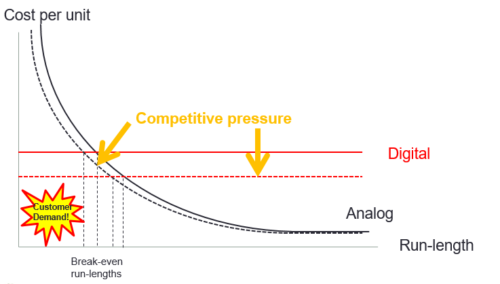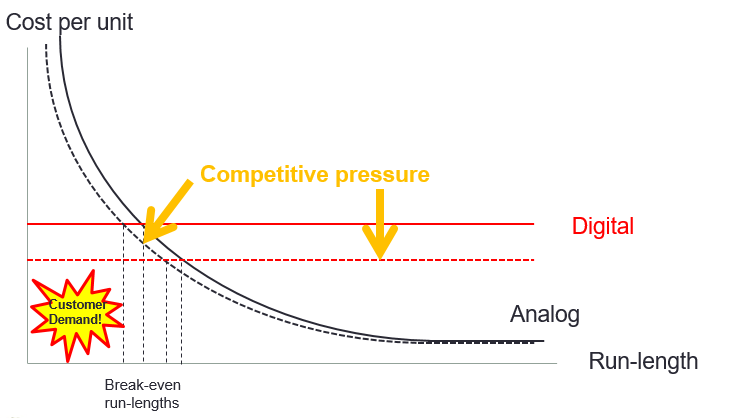My last article, Potential for Inkjet in Packaging broke the packaging market into four main segments (ignoring the container segment for now): labels, folding cartons, flexible packaging, and corrugated. We saw that, in terms of the number of impressions printed per year, these segments are overwhelmingly printed with conventional print technologies – offset lithography, gravure, flexography and screen printing. Digital technologies have gained a toe-hold in the label sector but, nearly a quarter-century after Benny Landa showed the first Indigo printer, toner and inkjet machines accounted for under 10% of the total volume of labels printed last year. We’ll explore some of the reasons for this, since these provide insights into the hurdles that digital technologies need to overcome in order to become relevant in the other packaging segments.
Digital Benefits
First, let’s review the benefits packaging print service providers get from digital printing, and why the label sector of the packaging market was the first to adopt digital technologies. The primary drivers for digital technology in all sectors are the familiar ones: shorter product lifecycles, proliferating numbers of SKUs, the need for localization, personalization, and traceability – all leading to shorter run-lengths for printers; and often to be delivered without an ability to charge a premium over their historical long-run pricing.
In general, digital printing (whether inkjet or toner) meets this need by avoiding conventional analog printing’s need for plate-making, set-up time and cost, make-ready waste, and clean-up. The cost per gallon of inkjet ink (or liquid toner) may be an order of magnitude greater than flexo ink, and the run-speeds may be lower but, for short runs, digital wins on cost, as depicted in the standard break-even curve. But the picture is not static – vendors of flexo presses are reducing set-up times with automatic plate-changing and other innovations, and digital printer vendors are increasing run-speeds and improving workflow software. The result is an arms race to get to where the customer wants to be: paying a long-run price for a short-run product.

Actually, what the customer wants is to be paying a long-run price for an on-demand product.
This aspect tends to be under-emphasized: customers often want quick turn-arounds, or JIT delivery of otherwise long-run orders. Many FMCG brands now require printers and converters to deliver daily or weekly in small batches – they may place a multi-month order, but will call it off in small quantities without indemnifying the printer against the risk of design changes. This requires the printer either to print on demand, and to live with the poor economics of analog short-runs (and the difficulty of color-matching batch-to-batch); or to print in volume, and take the risk that the remaining finished goods inventory may have to be scrapped because of a design or copy change. Without the economics of digital printing, this puts the supplier between a rock and a hard place.
Why Labels?
Of course, the rationale for going digital applies to every part of the printing market where digital has been substituting for analog for the past couple of decades. So why was the label sector the first packaging application to adopt inkjet technology for color printing? (From now on, given the focus of this website, I am going to concentrate on inkjet technology, despite the fact that toner-based systems led the digital trend in label printing, and the HP Indigo electrophotographic technology still dominates in terms of the installed base.)
Here is a good moment to clarify that I also propose to exclude from this discussion low-volume monochrome printers, often handheld or desktop, that use thermal transfer technology. These are characterized by low capital cost and relatively high consumables cost, so they are unsuited to high-volume use – unlike single-pass piezoelectric inkjet printers, where the reverse is true. (Thermal inkjet systems using aqueous inks occupy a large and expanding middle ground in this picture.)
Monochrome inkjet printers were first added to flexo presses to print barcodes or sequential numbering onto conventionally printed labels. Early systems using solvent inks suffered from nozzle blockages, and UV curable inks replaced them. The development of UV inks for wide-format printing, and more reliable printhead technology (especially in ink flow management) led to the advent in the mid-2000s of the first single-pass color printers.
I suggest that there are several reasons why the label market was the first target for these new printers:
- Label printing (unlike, say, flexible packaging) is a narrow web application. Web widths of 5-15 inches are common, needing few printheads to be ‘stitched’ together to create an array of nozzles spanning the width for each color. The number of printheads is a key cost-driver for the print engine, and piezoelectric printheads typically cost several thousand dollars each, so minimizing the capital investment was a key factor. The second factor is reliability: the probability of a nozzle blockage or ‘jet-out’ that can cause streaks on the print increases with the number of printheads. So fewer printheads means greater reliability1.
- Good print quality requires excellent control of the substrate during printing. As labels are typically printed roll-to-roll, and since web tension, weave and flutter are well-understood by web transport designers, it is easier to get good quality single-pass inkjet printing on a web than on a sheet – especially a narrow web.
- Most label stocks are suitable for inkjet printing. Inkjet (as I have noted in an earlier article) is unique in that the printed dots are not mechanically squashed into the substrate. This means that there must be good compatibility between the ink and the substrate in terms of surface energy and absorption. For UV-curable inks, this is generally not a problem with most plastic and paper stocks – although some may need pre-treatment for best results. Aqueous inks have historically had a narrower range of stocks on which acceptable print quality can be obtained.
- The label market is the most fragmented of all the packaging sectors. According to analysts LPC, Inc, the $12.2 billion North American tag & label revenues recorded in 2017 was shared among no less than 2,350 companies, most of them with annual sales under $5m. This is a fiercely contested market in which participants need to be responsive to threatening moves by competitors, like offering short-run options. The first company to adopt digital in a particular geographical market is likely to force adjacent competitors to follow. Also, these small companies often run older shaft-drive presses that take longer to set up and waste more material on changeovers, and these companies frequently outsource their plate-making. These factors make the cost benefits of digital printing for short runs even more attractive.
In the next article, we’ll look at what has held inkjet back in the label market and, by extension, what has caused even slower adoption in the rest of the packaging market – and how these limitations are being overcome.
Chris Lynn of Hillam Technology Partners provides product strategy & business development consulting for technology companies with a focus on digital print and packaging.
————————
1 An early color printer, the Jetrion 4000, used 2 Xaar 1001 printheads per color to print CMYK on a 5.5” web. Its sibling, the Jetrion 4830, was 3 heads wide for an 8.3” print swath.

